Related Research Articles

The RQ-3 DarkStar is an unmanned aerial vehicle (UAV). Its first flight was on March 29, 1996. The Department of Defense terminated DarkStar in January 1999, after determining the UAV was not aerodynamically stable and was not meeting cost and performance objectives.
An autonomous robot is a robot that acts without recourse to human control. The first autonomous robots environment were known as Elmer and Elsie, which were constructed in the late 1940s by W. Grey Walter. They were the first robots in history that were programmed to "think" the way biological brains do and meant to have free will. Elmer and Elsie were often labeled as tortoises because of how they were shaped and the manner in which they moved. They were capable of phototaxis which is the movement that occurs in response to light stimulus.
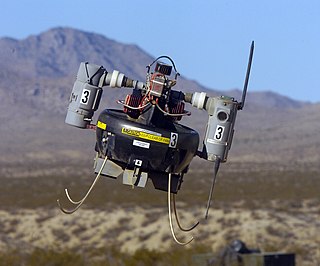
A micro air vehicle (MAV), or micro aerial vehicle, is a class of man-portable miniature UAVs whose size enables them to be used in low-altitude, close-in support operations. Modern MAVs can be as small as 5 centimeters - compare Nano Air Vehicle. Development is driven by commercial, research, government, and military organizations; with insect-sized aircraft reportedly expected in the future. The small craft allow remote observation of hazardous environments or of areas inaccessible to ground vehicles. Hobbyists have designed MAVs for applications such as aerial robotics contests and aerial photography. MAVs can offer autonomous modes of flight.

Teleoperation indicates operation of a system or machine at a distance. It is similar in meaning to the phrase "remote control" but is usually encountered in research, academia and technology. It is most commonly associated with robotics and mobile robots but can be applied to a whole range of circumstances in which a device or machine is operated by a person from a distance.

An unmanned ground vehicle (UGV) is a vehicle that operates while in contact with the ground and without an onboard human presence. UGVs can be used for many applications where it may be inconvenient, dangerous, or impossible to have a human operator present. Generally, the vehicle will have a set of sensors to observe the environment, and will either autonomously make decisions about its behavior or pass the information to a human operator at a different location who will control the vehicle through teleoperation.
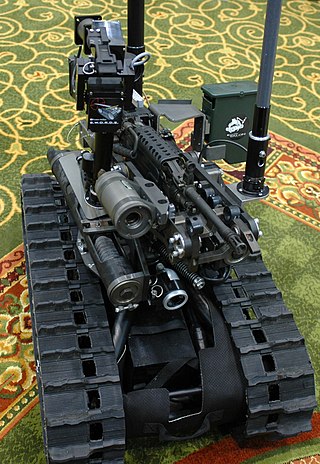
The Foster-Miller TALON is a remotely operated vehicle, and it is a small, tracked military robot designed for missions ranging from reconnaissance to combat. It is made by the American robotics company QinetiQ-NA, a subsidiary of QinetiQ.
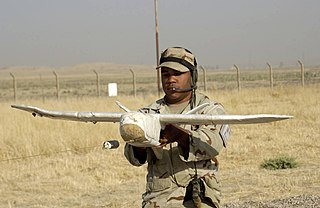
The Lockheed Martin Desert Hawk is a miniature UAV used for base perimeter protection. It was designed by Lockheed Martin's Skunk Works for the United States Air Force Force Protection Airborne Surveillance System (FPASS) Program on a quick-reaction contract issued late in the winter of 2002, with the first system delivered in the early summer. It was designed quickly, because the program leveraged technology and design studies developed for the MicroStar MAVs. The program was run by Electronic Systems Center. In 2007, the U.S. Air Force FPASS office switched all of their UAV systems over to the RQ-11B Raven.
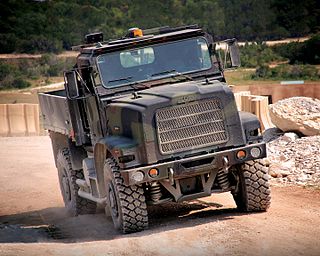
TerraMax is the trademark for autonomous/unmanned ground vehicle technology developed by Oshkosh Defense. Primary military uses for the technology are seen as reconnaissance missions and freight transport in high-risk areas so freeing soldiers from possible attacks, ambushes or the threat of mines and IEDs. The technology could also be used in civilian settings, such as autonomous snow clearing at airports.

The Kaman K-MAX is a helicopter with intermeshing rotors (synchropter) designed and produced by the American manufacturer Kaman Aircraft.

The Land Tamer is a range of remote access vehicles made by the Hydratrek company.

The Legged Squad Support System (LS3) was a DARPA project for a legged robot which could function autonomously as a packhorse for a squad of soldiers or marines. Like BigDog, its quadruped predecessor, the LS3 was ruggedized for military use, with the ability to operate in hot, cold, wet, and dirty environments. The LS3 was put into storage in late 2015.

The Ripsaw is a series of developmental unmanned ground combat vehicles designed by Howe & Howe Technologies for evaluation by the United States Army.
The Modular Advanced Armed Robotic System (MAARS) is a robot that is being developed by Qinetiq. A member of the TALON family, it will be the successor to the armed SWORDS robot. It has a different, larger chassis than the SWORDS robot, so has little physically in common with the SWORDS and TALON

The Aerial Reconfigurable Embedded System (ARES) was a concept for an unmanned VTOL flight module that can transport various payloads. The concept started as the TX (Transformer) in 2009 for a terrain-independent transportation system centered on a ground vehicle that could be configured into a VTOL air vehicle and carry four troops. ARES' primary function was the same as TX, to use flight to avoid ground-based transportation threats like ambushes and IEDs for units that don't have helicopters for those missions. It was to be powered by twin tilting ducted fans and have its own power system, fuel, digital flight controls, and remote command-and-control interfaces. The flight module would have different detachable mission modules for specific purposes including cargo delivery, CASEVAC, and ISR. Up to 3,000 lb (1,400 kg) of payload would be carried by a module.
Adaptive collaborative control is the decision-making approach used in hybrid models consisting of finite-state machines with functional models as subcomponents to simulate behavior of systems formed through the partnerships of multiple agents for the execution of tasks and the development of work products. The term “collaborative control” originated from work developed in the late 1990s and early 2000 by Fong, Thorpe, and Baur (1999). It is important to note that according to Fong et al. in order for robots to function in collaborative control, they must be self-reliant, aware, and adaptive. In literature, the adjective “adaptive” is not always shown but is noted in the official sense as it is an important element of collaborative control. The adaptation of traditional applications of control theory in teleoperations sought initially to reduce the sovereignty of “humans as controllers/robots as tools” and had humans and robots working as peers, collaborating to perform tasks and to achieve common goals. Early implementations of adaptive collaborative control centered on vehicle teleoperation. Recent uses of adaptive collaborative control cover training, analysis, and engineering applications in teleoperations between humans and multiple robots, multiple robots collaborating among themselves, unmanned vehicle control, and fault tolerant controller design.
The Lockheed Martin Desert Hawk III (DHIII) is a miniature UAV designed by the Lockheed Martin Aeronautics in 2006 for use by modern militaries. It is a small surveillance drone, which is mainly used by the United Kingdom, but has also been used by the United States to assist in the war on terror by executing reconnaissance and recovery missions.
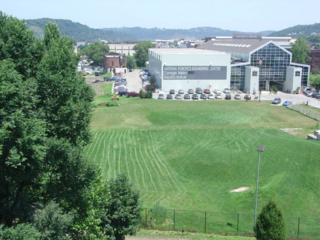
The National Robotics Engineering Center (NREC) is an operating unit within the Robotics Institute (RI) of Carnegie Mellon University. NREC works closely with government and industry clients to apply robotic technologies to real-world processes and products, including unmanned vehicle and platform design, autonomy, sensing and image processing, machine learning, manipulation, and human–robot interaction.

Counter-IED equipment are created primarily for military and law enforcement. They are used for standoff detection of explosives and explosive precursor components and defeating the Improvised Explosive Devices (IEDs) devices themselves as part of a broader counter-terrorism, counter-insurgency, or law enforcement effort.
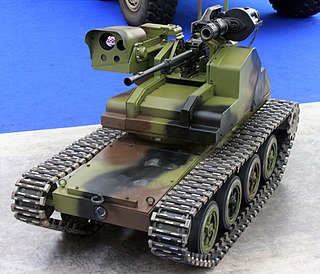
Miloš, also called Little Miloš, is an unmanned ground vehicle (UGV) developed by the Military Technical Institute, following the development of unmanned ground vehicle Milica in 2009. UGV Miloš is in serial production and first customer are Serbian Armed Forces.
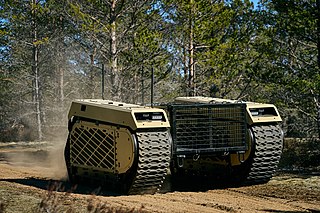
Integrated Modular Unmanned Ground System (UGS or iMUGS) is a European Union's Permanent Structured Cooperation (PESCO) project that aims to create a European standard unmanned ground system and develop scalable modular architecture for hybrid manned-unmanned systems, as well as increasing interoperability, situational awareness and speeding up decision making. The project is coordinated by Estonia, with 10 other European countries participating. It will use Milrem's existing THeMIS unmanned ground vehicle for different payloads.
References
- ↑ Kris Osborn (2009-03-15). "Army Robots: Will Humans Still Be in Control?". Time magazine . Archived from the original on March 16, 2009. Retrieved 2009-03-16.
- ↑ Gizmag SMSS
- ↑ Lockheed SMSS pdf - Lockheed
- 1 2 Robotic Mule Vendors Seek Opportunities Outside Military Archived 2013-07-05 at archive.today - Nationaldefensemagazine.org, July 2013
- ↑ SMSS in Afghanistan - Unmanned Systems Technology.com, May 24, 2012
- ↑ Lockheed Martin’s SMSS Unmanned Autonomous Vehicle Operates Via Satellite Control - Lockheed press release, February 19, 2013
- ↑ UGV models face off over firepower, load carrying - Armytimes.com, 12 October 2013
- ↑ Four companies advance to build Army’s equipment transport ground robot - Defensenews.com, 14 December 2017
- ↑ US Army, Lockheed Martin Test Collaborative Robotics at Ft Benning - Defense-Update.com, 18 August 2014